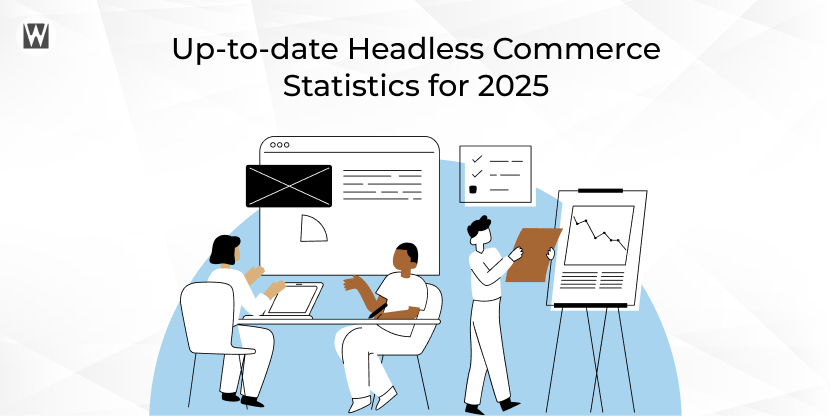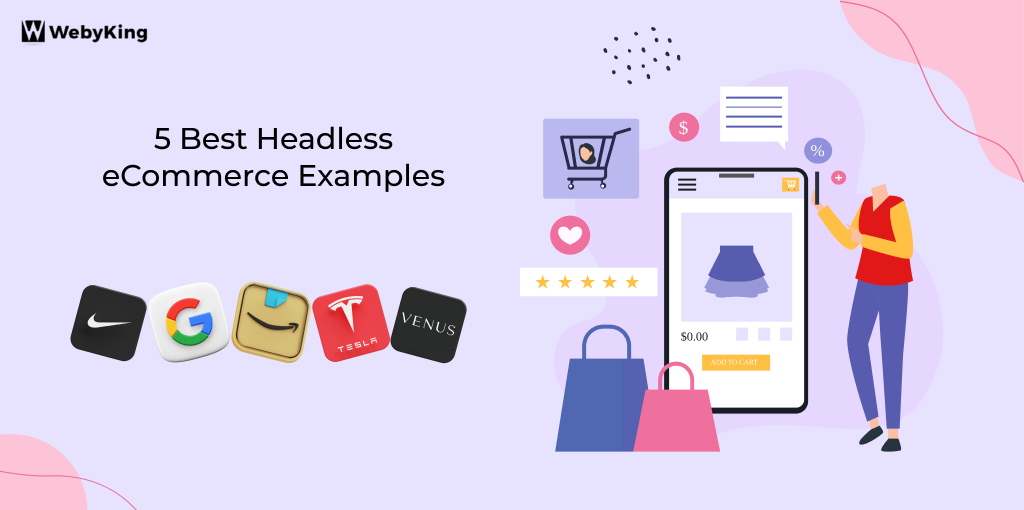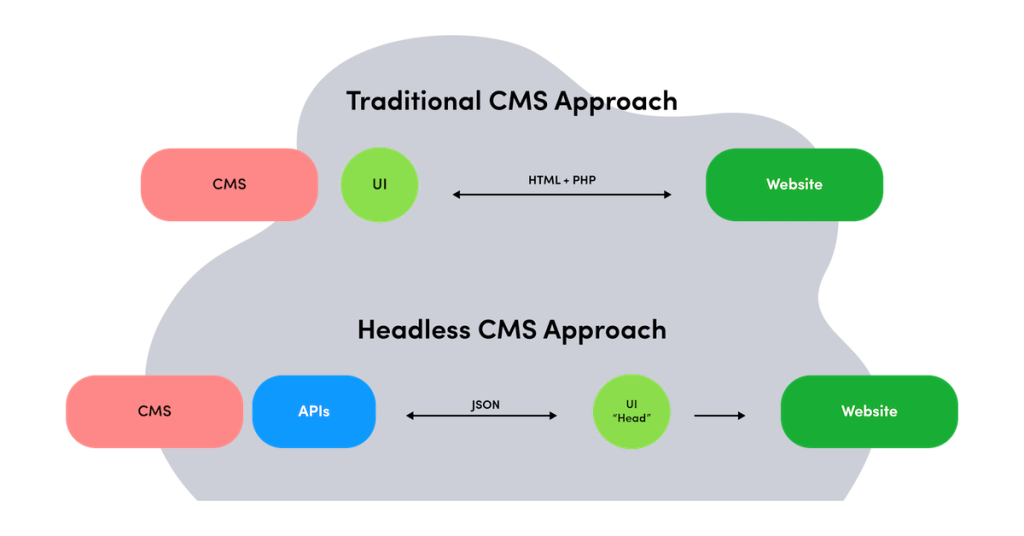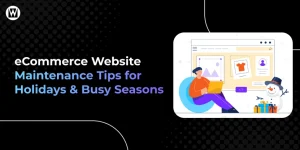Up-to-date Headless Commerce Statistics for 2025

Due to the growth of digital commerce, businesses are under more pressure than ever to provide seamless, customized customer experiences across various channels. These changing expectations are too much for traditional eCommerce platforms, which are frequently inflexible and monolithic.
For example, these platforms frequently struggle with sluggish load times, adding new features, and managing higher traffic volumes.
Providing outstanding customer experiences is more important than ever, as global eCommerce sales are expected to reach $7 trillion by 2025. To deliver a unified customer experience, online retailers must keep pace with evolving technological trends. But how?
Well, enter the headless commerce era.
Businesses are given the flexibility and agility they need to provide outstanding customer experiences by separating the storefront from the backend operations. This architecture allows retailers to interact consistently across multiple platforms, including websites and mobile apps.
But what is it? Is headless commerce here to stay? Or is it a fad? Don’t worry; to answer these questions, refer to the blog and explore its current stats.
What is Headless Commerce?
Headless commerce is a cutting-edge method of eCommerce that divides an online store’s front and back ends. Decoupling like this promotes personal growth on both sides, which results in unparalleled adaptability and personalization.
Businesses can integrate systems modularly using a headless commerce approach, allowing them to customize front-end user experiences without affecting back-end operations.
The potential of headless commerce is already being shown by popular brands like Burrow, Netflix, and Chico’s FAS, which use it to create seamless customer experiences.
According to WP Engine’s The State of Headless 2021 Report, two-thirds of Australian businesses (66%) currently use headless technologies and one in five businesses (21%) plan to do so within the next 12 months. This indicates that headless adoption is on the rise in Australia.
Crucially, headless commerce isn’t limited to big businesses. Numerous tech firms, such as WP Engine, can assist small and medium-sized enterprises in putting in place a headless commerce solution customized to meet their objectives, even though they might not have the same resources or workforce as larger organizations.
Headless Commerce Statistics You Should Know
- The headless commerce market is expected to reach $11.8 billion by 2028, growing at a compound annual growth rate (CAGR) of 17.5%.
- Organizations typically invest $2.6 million to implement headless architecture.
- Due to essential players and early adoption, North America is expected to hold the largest share of the headless commerce market from 2021 to 2028.
- Improved customer experience, increased flexibility, and faster site performance are the core advantages of headless commerce.
80% of companies that do not currently use headless architecture say they intend to do so within the next two years.
Agility is crucial for success because consumer preferences, market trends, and business requirements change quickly. Avoiding the creation of a time-consuming bottleneck is vital when it comes to online stores. Your teams’ customer experience and productivity may suffer from a complicated backend.
Other Jaw-dropping Statistics
- 57% of retailers used or considered a headless commerce architecture in 2020.
- Conversion rates increased by 25% for brands that used headless commerce platforms.
- Businesses that adopted headless commerce saw a 50% reduction in the time it took to launch new digital experiences.
- 54% of businesses say they are more productive when they use APIs.
According to the most recent data on headless commerce, businesses should consider switching now to remain competitive.
North America, Australia, and Europe spearhead this trend because of their higher adoption rates and more sophisticated technologies.
Although moving to a headless commerce market may present specific difficulties, such as managing integrations, the advantages of improved customer experiences and faster website speeds make the decision worthwhile.
5 Best Headless eCommerce Examples

Nike, Target, and Under Armour are notable examples of companies that use this architecture to improve customer engagement and optimize operations across multiple channels. With this strategy, brands can increase conversion rates and provide individualized experiences.
Nike
Nike used a React single-page application (SPA) and a Node.js backend for the front end (BFF) to realize this goal. The speed and flexibility required for a smooth user experience across devices were made possible by this contemporary architecture.
The result? Nike’s market position is strengthened by a significant rise in mobile conversions.
Google Cloud and headless commerce pioneer Commercetools have teamed up to make their cloud-native SaaS platform available on Google Cloud Marketplace.
Amazon
Amazon Web Services (AWS) is the world’s biggest cloud platform. It provides a range of cloud computing services, including an adaptable platform for API-first merchandising. AWS’s headless solution provides scalable and versatile features like fraud detection, video commerce, and integrations with other eCommerce platforms.
Tesla
Tesla’s headless eCommerce system, which allows customers to customize their cars by selecting materials or colors, has optimized the retail experience for its customers. Flexible API-enabled features have enabled Tesla to offer superior delivery, trial, and refund options for car purchases and quicker and better customer service.
Venus
Venus, a well-known women’s clothing retailer, had slow loading times; over 80% of its website pages took longer than a second to load. Venus implemented Headless Commerce, transformed their storefront into a React Progressive Web App, and upgraded their infrastructure to a BFF (Backend for Frontend) to increase their conversion rate and site speed.
Headless Commerce is the Future

Source: ButterCMS
In today’s competitive and saturated digital world, businesses need more than just a typical eCommerce platform where buyers and sellers can shop and pay. The need for personalization, agility, and appealing user experience has never been greater.
Enter headless commerce – a revolutionary approach to retailers that decouples the front and back end, offering the finest flexibility and control.
This innovative and emerging solution allows businesses to deliver personalized, consistent, high-performing experiences across multiple touchpoints, whether on the web, mobile, IoT devices, or even modern technologies like voice assistants.
As customer preferences change and technology advances, headless commerce is undoubtedly the future. It offers retailers a competitive edge by providing the speed and personalization needed to stay ahead.
At WebyKing, our expert eCommerce development team will help you build a future-proof headless solution tailored to your business requirements. Contact us now, and let’s take your digital commerce strategy to the next horizon.
Frequently Asked Questions
Why is it referred to as a "headless" business?
Since the front-end presentation layer, also known as the head, is separated and eliminated, leaving only the backend application layer, this commerce method is known as headless. A headless system can handle, store, process, and distribute content without a front end.
How much does a headless cost?
Headless cost depends on your store size and requirements. To get an accurate estimate of headless, contact an experienced eCommerce development company.
What is headless eCommerce architecture?
The separation of the commerce solution’s front-end and back-end components is known as headless architecture. These separate layers are interconnected.
Whether you’re upgrading technology, improving performance, or rebranding your business, this checklist ensures a smooth and successful migration every step of the way. Get Your Free Checklist Now!


Ravi Makhija, the visionary Founder and CEO of WebyKing, is a seasoned digital marketing strategist and web technology expert with over a decade of experience. Under his leadership, WebyKing has evolved into a premier full service web and marketing agency, delivering innovative solutions that drive online success. Ravi’s deep understanding of the digital landscape combined with his passion for cutting-edge technologies empowers him to consistently exceed client expectations and deliver results that matter.

![How to Build an eCommerce Website From Scratch? [A Step-By-Step Guide] How to Build an eCommerce Website from Scratch](https://www.webyking.com/wp-content/uploads/2023/05/How-to-Build-an-eCommerce-Website-from-Scratch-e1722318490903-300x136.jpg)
![How Much Does An Ecommerce Website Cost In 2025 [A Complete Pricing Guide] Featured Image of eCommerce Website Cost](https://www.webyking.com/wp-content/uploads/2021/12/ecommerce-website-cost-300x150.webp)













